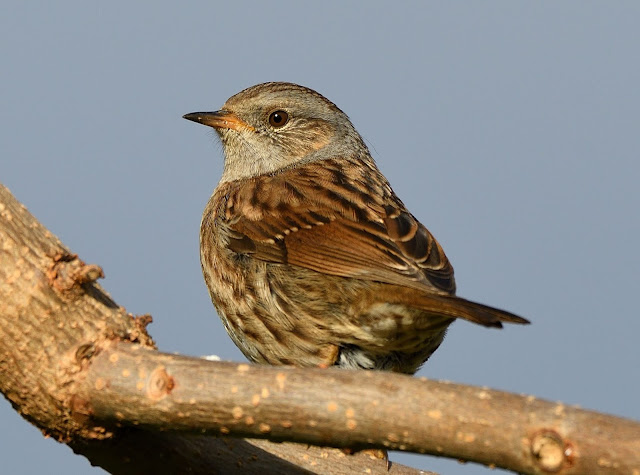There has been a serious, countrywide, decline in the numbers of many birds, including many well known and loved species such as the song thrush, skylark, starlings, blackbirds and house sparrow. Their numbers have fallen by an alarming 85% in just 30 years and they have now become a rare sight in our gardens.
 |
| Once common in our gardens, the Dunnock is now a very rare sight! |
This decline has been gradual in some species, but simply alarming in others. Most of the declining species are farmland birds. On the other hand, most woodland species such as the blue tit, nuthatch and great spotted woodpecker are still doing alright. However, declines may have started in woodland habitat also, with lesser spotted woodpecker and willow tit now red-listed because of their severe declines.
Extensive research has shown that these declines are caused primarily by changes in agriculture. Although the actual factors that cause the decline are similar to most species, the exact way they act differs, which is why some species have been declining for 30 years, while in others the decline has only become prominent in the past 10 years.
Changes in agricultural practices have had a devastating effect on farmland birds. This process has been fuelled, particularly in north-west Europe, by European agricultural policies.
Many people don’t think this would be the reason for the decline of birds in suburban and urban areas. However, as 80 per cent of this country is farmland, what happens there will affect birds in all habitats. This is especially true of urban populations, since in most cases, the urban and suburban populations are an overspill from the better habitats in the countryside.
I regularly put out feed, to attract birds to my garden and the following images show just some of the visitors that we enjoy watching and listening to.
All shots were taken with my Nikon D500 and Nikon 70-200 f4, or Nikon 200-500 f5.6 lenses.
 |
| Common Chaffinch |
 |
| our resident 'Little Owl' |
 |
| Not so Common Blackbird gathering lunch for its chicks. |
 |
| Green Woodpecker on a rainy day. |
 |
| Robin |
 |
| Used to be the most common bird, but now on the Danger list - House Sparrow |
 |
| Great Tit |
 |
| Starling is another bird in trouble |
 |
| Black Redstart |
 |
| Eurasian Siskin |
 |
| Stonechat |
 |
| Blue Tit |
 |
| Wheatear in full song |
 |
| Collared Dove |
 |
| Hawfinch |
 |
| Wagtail |
 |
| this Kestrel is a regular visitor over our land. |
 |
| Buzzards are a common sight here in the Dordogne |
 |
| This Buzzard has a full crop after a recent kill. |
It is important that we ALL do what we can to protect birds and encourage them into our gardens. From putting out feeders and water, to avoiding the use of pesticides and leaving plastic rubbish in our garden, there is always something that we can do to help them.
If you have a suitable place to put out nesting boxes, you will be surprised at how quickly birds will make use of them. The trick is to place them where the birds want them, rather than where you would like to see them! In addition, check on the internet to understand which type of nesting box, will attract which type of birds.
If you enjoy reading my photoblogs, please 'subscribe' by clicking on the link at the top of the page and 'share' my blogs on facebook etc with your friends.

























You have much the same as us in the garden though I have not seen a Wheatear or a Stonechat. I am also jealous of the Kestrel, wish it would visit us. I have only ever seen one Dunnock at a time here. but over the past 12 years there has always been one around. Hope all is well things have not been easy here but hope to see you in February. All the best to you both, Diane
ReplyDelete